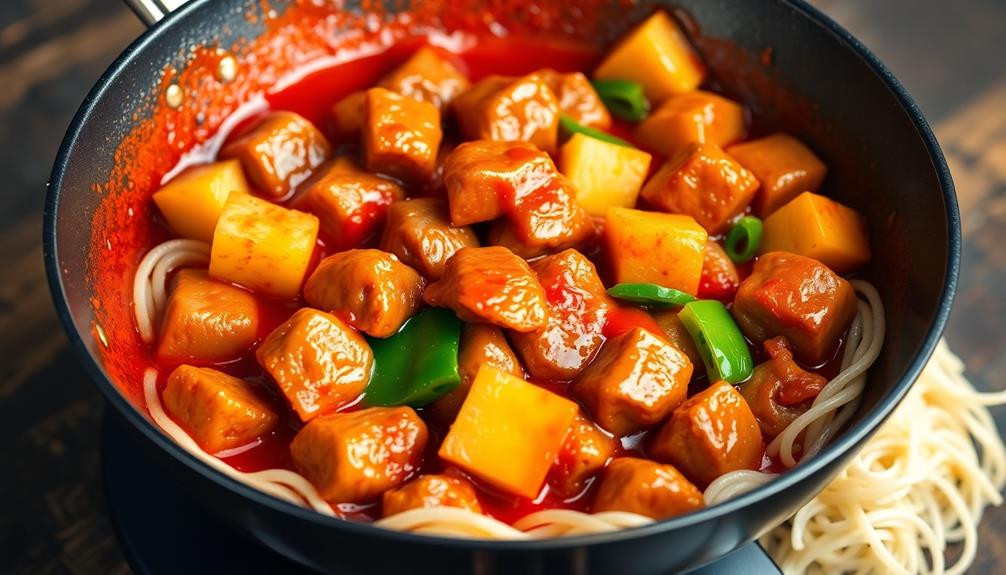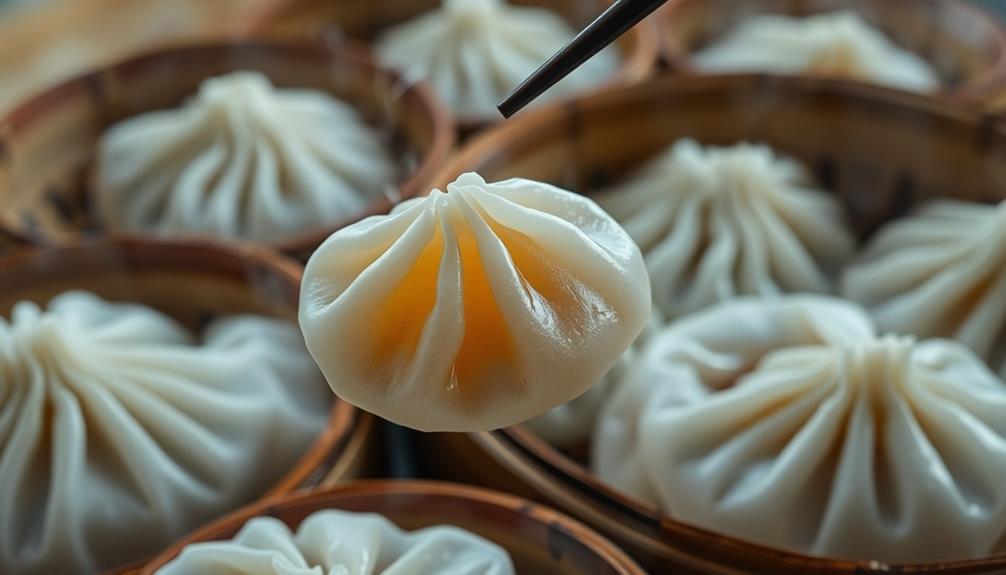If you're craving a classic Chinese dish that'll tantalize your tastebuds, you've gotta try sweet and sour pork! This vibrant stir-fry has its roots in Cantonese cuisine, and it's become a global sensation thanks to its mouthwatering blend of tender pork, crisp veggies, and a signature sauce that strikes the perfect balance between sweetness and tang. Whether you're enjoying it at your favorite Chinese restaurant or whipping it up in your own kitchen, this dish is a true celebration of the art of blending flavors. And if you keep reading, you'll discover the secrets to making this iconic dish at home!
Key Takeaways
- Sweet and sour pork is a classic Cantonese dish known for its perfect balance of sweet and tangy flavors.
- The dish typically includes tender pork, vibrant vegetables like bell peppers and pineapple, and a sauce made from vinegar, sugar, and soy sauce.
- Proper preparation techniques, such as marinating the pork and coating it in cornstarch before frying, are crucial for achieving the desired texture and flavor.
- Achieving the right balance of sweet and sour in the sauce is essential for the dish's success, and it often requires practice and patience.
- Sweet and sour pork is a beloved dish that has stood the test of time, representing the art of blending diverse flavors in Chinese cuisine.
History
Sweet and sour pork's origins can be traced back to the Cantonese cuisine of southern China. This beloved dish has been enjoyed for centuries, with its perfect balance of flavors – the sweetness of fruit and the tanginess of vinegar.
It's a true taste of Chinese culinary heritage!
You might be surprised to learn that the recipe has evolved over time. Traditional versions often included ingredients like pineapple, bell peppers, and onions.
Nowadays, chefs get creative, adding their own unique twists. Some might use different types of vinegar or play around with the sauce consistency.
No matter how it's made, sweet and sour pork is a crowd-pleaser. The tender pork, cooked to perfection, paired with the vibrant colors and irresistible flavors – it's no wonder this dish has become a staple in Chinese restaurants around the world.
Get ready to enjoy a delicious taste of history in every bite!
Recipe
Sweet and Sour Pork is a classic Chinese dish that combines tender pork, crisp vegetables, and a tangy, flavorful sauce. The combination of sweet and sour flavors creates a delightful balance that's sure to please your taste buds.
For those looking to enhance their dining experience, pairing this dish with a soothing herbal tea can add a layer of relaxation and aid digestion, making it a perfect complement to your meal. Herbal teas like peppermint or ginger can be particularly beneficial in this regard, offering health benefits that enhance your overall enjoyment.
The key to making this dish is to properly prepare the pork and create a well-balanced sauce. By following this recipe, you'll be able to recreate the authentic flavors of this beloved dish in your own kitchen.
Ingredients:
- 1 lb pork, cut into 1-inch cubes
- 1 bell pepper, diced
- 1 onion, diced
- 1 can (20 oz) pineapple chunks, drained (juice reserved)
- 2 tablespoons vegetable oil
- 2 cloves garlic, minced
- 1 tablespoon grated ginger
- 2 tablespoons soy sauce
- 2 tablespoons rice vinegar
- 2 tablespoons brown sugar
- 1 tablespoon ketchup
- 1 teaspoon cornstarch
- Salt and pepper to taste
Instructions:
In a large skillet or wok, heat the vegetable oil over medium-high heat. Add the pork cubes and cook until browned on all sides, about 5-7 minutes. Remove the pork from the skillet and set aside.
In the same skillet, sauté the garlic and ginger until fragrant, about 1 minute. Add the bell pepper and onion, and cook for 2-3 minutes until slightly softened.
Pour in the reserved pineapple juice, soy sauce, rice vinegar, brown sugar, and ketchup. Whisk in the cornstarch and bring the mixture to a simmer, stirring occasionally, until the sauce thickens, about 2-3 minutes.
Return the cooked pork and pineapple chunks to the skillet, and toss to coat everything in the sauce. Cook for an additional 2-3 minutes, or until the pork is heated through and the sauce has reached the desired consistency. Season with salt and pepper to taste.
Serving this dish with steamed rice is the perfect accompaniment. Be sure to adjust the sweetness and sourness to your personal preference for the ultimate sweet and sour experience.
Cooking Steps
Cut those pork chunks into bite-sized pieces, then let 'em soak up all the flavors in a soy sauce marinade.
Next, coat the pork in some cornstarch to get it nice and crispy when you fry it up until it's golden brown. This step is crucial in creating the perfect texture for the pork in this traditional Sichuan cuisine recipe. The cornstarch helps to create a light and crispy outer layer that is characteristic of this dish. It also helps to lock in the moisture of the pork, ensuring that it stays tender and juicy.
Step 1. Cut Pork Into Bite-Size Pieces
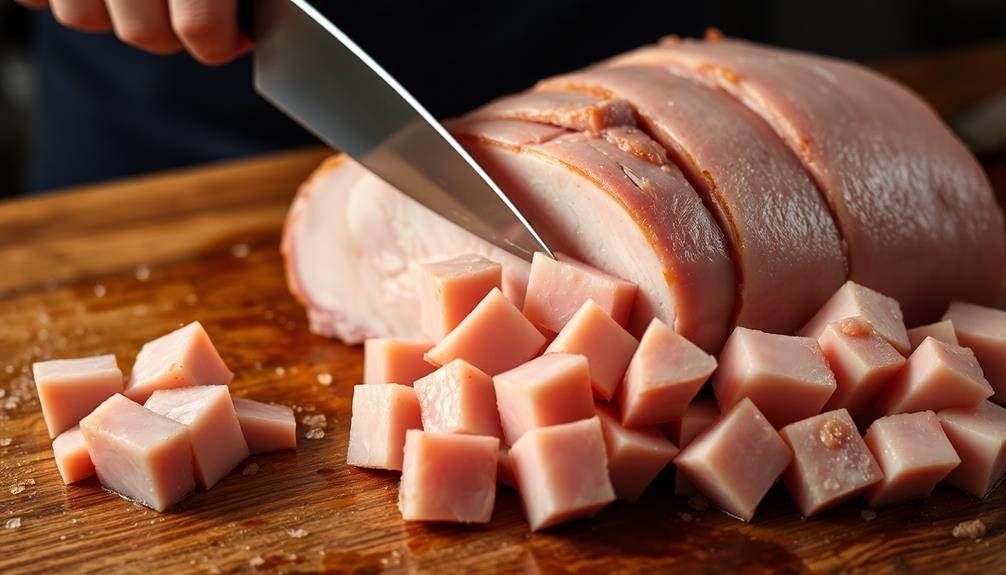
Once you have the pork ready, begin by cutting it into bite-size pieces.
You'll want to make sure the pieces are around 1-inch cubes – not too big, not too small. Use a sharp knife and work carefully, taking your time to get nice, even cuts. This will help the pork cook evenly later on.
As you're cutting, be mindful of your fingers and keep them tucked away from the blade. Once all the pork is in bite-size pieces, give them a quick rinse under cool water to wash away any bits of bone or gristle.
Pat the pork dry with some paper towels so it's ready to go for the next step.
With your pork all prepped and ready, you can move on to the next part of the cooking process. Just wait until you see how the flavors come together – your taste buds are in for a real treat!
Step 2. Marinate Pork in Soy Sauce
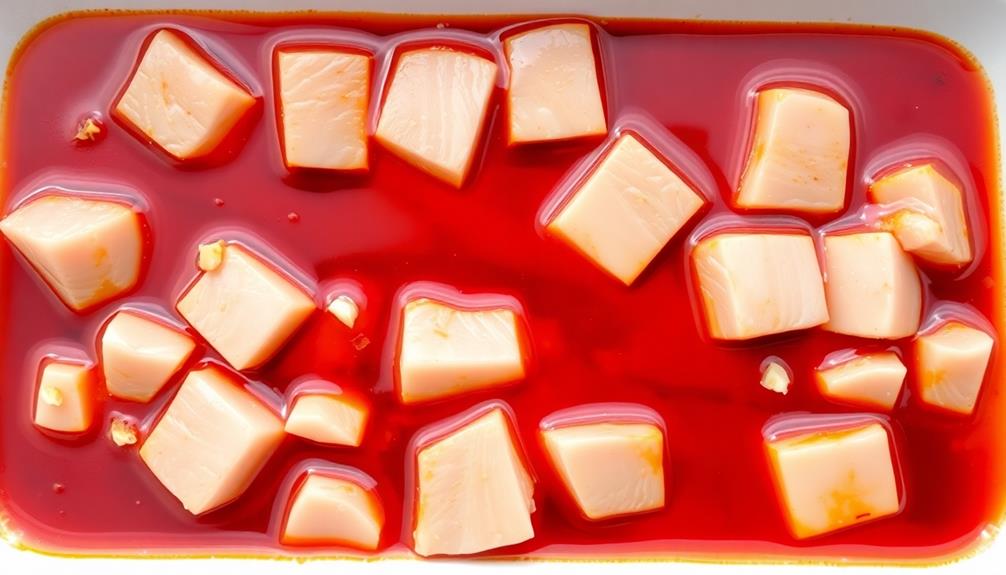
To impart the pork with a tantalizing flavor, begin by marinating it in a blend of soy sauce and aromatic seasonings.
In a large bowl, combine the bite-sized pork pieces with a generous amount of soy sauce. Stir to ensure the pork is evenly coated.
Next, add a pinch of garlic powder, a sprinkle of ground ginger, and a dash of white pepper. Give the mixture a good stir, making sure all the pork pieces are well-seasoned.
Cover the bowl and let the pork marinate in the fridge for at least 30 minutes, or up to 2 hours for maximum flavor. The soy sauce will help tenderize the meat, while the seasonings will infuse it with a delightful aroma and depth of taste.
When you're ready to cook, the pork will be perfectly prepared to sizzle in the pan, ready to become the star of your sweet and sour dish.
Step 3. Coat Pork in Cornstarch
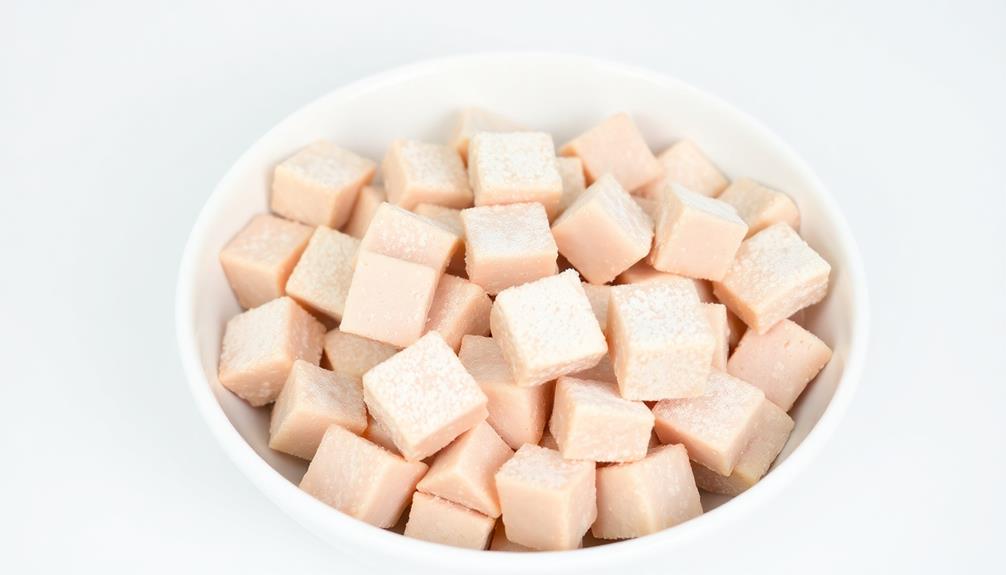
After allowing the pork to soak up the flavors in the marinade, it's time to coat the pieces in cornstarch. This step is crucial for creating that delightful crunch you'll find in the final dish.
Simply take the marinated pork cubes and toss them in a bowl filled with cornstarch. Make sure each piece is thoroughly coated – you want an even, light layer of that magical starch.
Don't be afraid to use your hands to gently massage the cornstarch onto the pork. This ensures every nook and cranny is covered.
Once the pork is coated, shake off any excess cornstarch. You don't want clumps or a heavy coating, just a light dusting.
Now your pork is ready for the next step – frying to golden perfection! Get excited, because the sweet and sour flavors are about to come to life in the most delicious way.
Step 4. Fry Pork Until Golden Brown
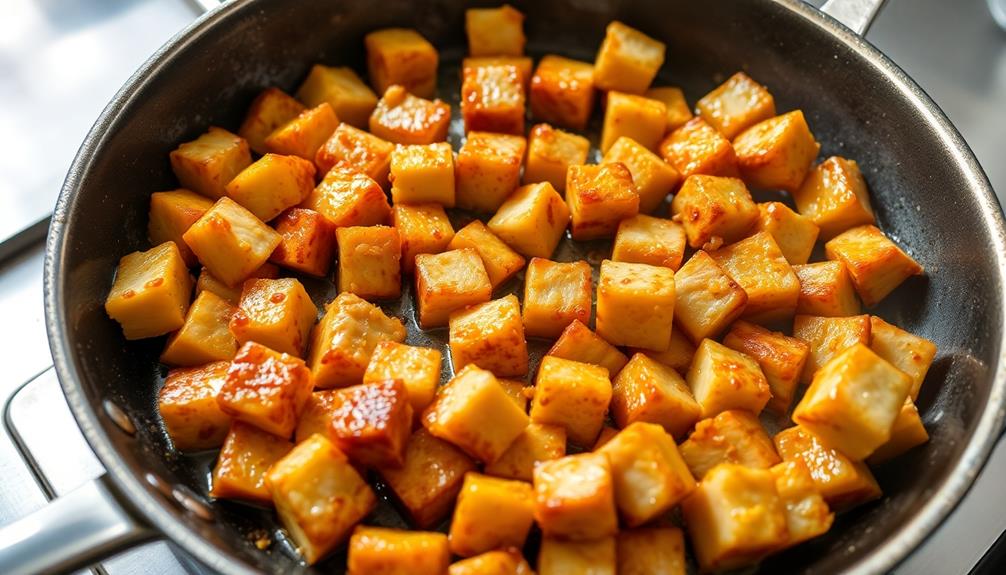
Heat a large skillet or wok over medium-high heat. Once it's nice and hot, add a few tablespoons of oil – just enough to lightly coat the bottom.
Carefully add the cornstarch-coated pork pieces, making sure they don't overcrowd the pan. You want them to have a bit of space so they can really get crispy!
Fry the pork, turning occasionally, until it's a lovely golden brown all over. This should take around 5-7 minutes. The pork will sizzle and pop as it cooks, filling your kitchen with that amazing fried food aroma.
Keep an eye on it and adjust the heat if needed to prevent burning.
Once the pork is perfectly crispy, use a slotted spoon to transfer it to a plate lined with paper towels. This will help soak up any excess oil, leaving you with pork that's wonderfully crunchy on the outside but still juicy on the inside.
Now you're ready to toss the pork in the sweet and sour sauce – get ready for an explosion of flavor!
Step 5. Make Sweet and Sour Sauce
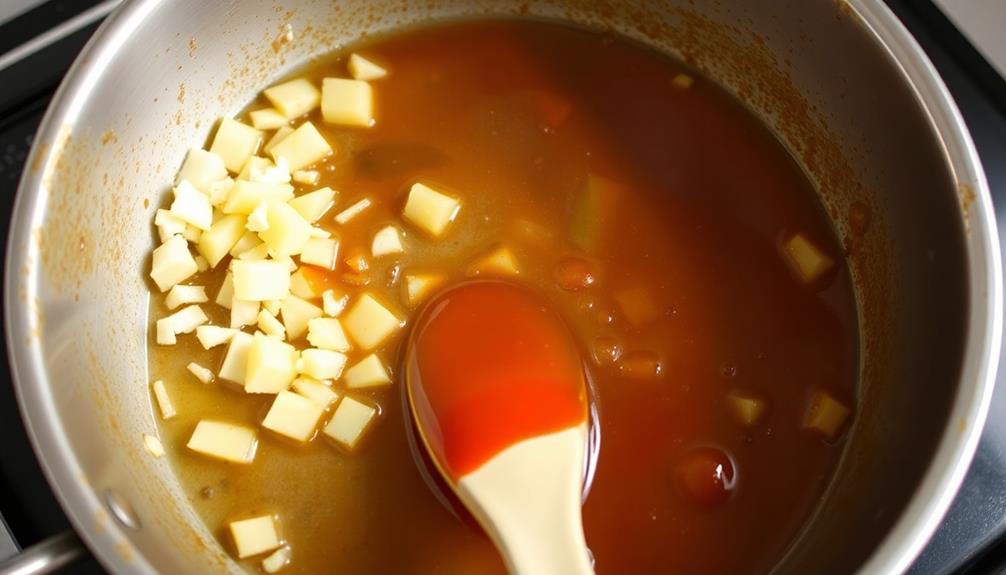
While the pork is frying, start preparing the sweet and sour sauce. In a medium-sized bowl, combine the ketchup, vinegar, soy sauce, and brown sugar. Whisk the ingredients together until the sugar has dissolved, and the sauce is smooth.
Next, add the garlic, ginger, and red pepper flakes to the sauce. Stir everything together, making sure the flavors are well-incorporated. If you like your sauce with a bit of a kick, add a touch more red pepper flakes.
Once the pork is cooked, drain the excess oil from the pan. Carefully pour the sweet and sour sauce over the pork, making sure to coat each piece evenly.
Bring the sauce to a simmer and let it thicken slightly, about 2-3 minutes.
Serve the delicious sweet and sour pork over steamed rice or noodles. Enjoy the perfect balance of sweet, sour, and savory flavors in every bite!
Final Thoughts
With a satisfying blend of sweet and tangy flavors, the sweet and sour pork dish is a culinary delight that has stood the test of time.
You've nailed the perfect balance of ingredients, creating a mouthwatering meal that's sure to impress your family and friends. As you take that final satisfying bite, you can't help but smile, knowing you've mastered this classic dish.
While the journey of perfecting sweet and sour pork may have had its ups and downs, the end result is well worth the effort.
The tender pork, the vibrant vegetables, and the tantalizing sauce come together in a harmonious dance on your plate. This dish is a true celebration of the art of Chinese cuisine, a testament to the power of blending diverse flavors and textures. Each bite reveals layers of complex flavors, from the rich, savory notes of the sauce to the subtle sweetness of the pork. The vibrant colors of the vegetables add a beautiful contrast, enhancing both the visual appeal and the overall experience. For an unforgettable version, the *redbraised pork belly recipe* elevates this dish to new levels of indulgence, offering a melt-in-your-mouth tenderness that echoes the heart of traditional Chinese cooking.
Frequently Asked Questions
What Is the Origin of Sweet and Sour Pork?
Well, the origins of sweet and sour pork can be traced back to Chinese cuisine, where the combination of contrasting flavors has been a staple for centuries, reflecting the country's rich culinary traditions.
How Can I Make the Pork Crispy?
To make the pork crispy, you'll want to fry it in small batches at a high temperature until it's golden brown and crunchy. Be sure to thoroughly pat the pork dry before cooking to get the best texture.
Can I Use a Different Protein Instead of Pork?
You can definitely use a different protein instead of pork. Chicken, tofu, or even shrimp would work well in this recipe. Just be sure to adjust the cooking time and method accordingly.
How Long Does It Take to Prepare and Cook?
You can prepare and cook this dish in about 30-45 minutes. The actual cooking time will depend on the specific ingredients and cooking method you choose, but it's generally a quick and easy meal to make.
What Are Some Variations of Sweet and Sour Pork?
There are several variations of this classic dish you can try. You could use chicken or shrimp instead of pork. You could add vegetables like bell peppers, pineapple, or onions. You could even make a vegetarian version using tofu.
